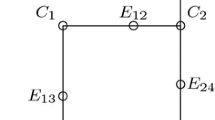Abstract
A two locus deterministic population genetic model is analysed. One locus is under viability selection, the other under fertility selection with both forms of selection completely symmetric. It is shown that linkage equilibrium may occur at two different equilibrium points. For a two-locus polymorphism to be stable, it is necessary that the viability locus be overdominant but not necessary that the fertility locus, considered separately, be able to support a stable polymorphism. The overlaps in stability are not as complex as under two locus symmetric fertilities, but considerably more complex than with symmetric viabilities. Extensions of the analysis for the central linkage equilibrium point with multiple viability and fertility loci are indicated.
Similar content being viewed by others
References
Bodmer, W. F.: Differential fertility in population genetic models. Genetics 51, 411–424 (1965)
Brittnacher, J. G.: Genetic variation and genetic load due to the male reproductive component of fitness in Drosophila, Genetics 97, 719–730 (1981)
Bundgaard, J., Christiansen, F. B.: Dynamics of polymorphisms. I. Selection components in an experimental population of Drosophila melanogster, Genetics 71, 439–460 (1972)
Clark, A. G., Bundgaard, J.: Selection components in background replacement lines of Drosophila. Genetics 108, 181–200 (1984)
Clark, A. G., Feldman, M. W.: The estimation of epistatis in components of fitness in experimental populations of Drosophila melanogaster. I. A two stage maximum likelihood model, Heredity 46, 321–346 (1981a)
Clark, A. G., Feldman, M. W.: The estimation of epistasis in components of fitness in experimental populations of Drosophila melanogaster. II. Assessment of meiotic drive, viability, fecundity and sexual selection, Heredity, 46, 347–377 (1981b)
Clegg, M. T., Kahler, A. L., Allard, R. W.: Estimation of life cycle components of selection in an experimental plant population, Genetics 89, 765–792 (1978)
Feldman, M. W., Christiansen, F. B., Liberman, U.: On some models of fertility selection, Genetics 105, 1003–1010 (1983)
Feldman M. W., Liberman, U.: A symmetric two locus fertility model. Genetics. 109, 229–253 (1985)
Franklin, I., Lewontin, R. C.: Is the gene the unit of selection? Genetics 65, 707–734 (1970)
Gregorius, H. R., Ziehe, M.: Viability-fecundity selection at a single multiallelic locus in random mating populations: protectedness of an allele. Math. Biosci. 61, 29–50 (1982)
Hadeler, K. P., Liberman, U.: Selection models with fertility differences, J. Math. Biol. 2, 19–32 (1975)
Karlin, S., Avni, H.: Analysis of central equilibria in multilocus systems: A generalized symmetric viability regime. Theor. Pop. Biol. 20, 241–280 (1981)
Karlin, S., Feldman, M. W.: Linkage and selection: two locus symmetric viability models, Theor. Pop. Biol. 1, 38–71 (1970)
Karlin, S., Raper, J.: Preferential mating in symmetric multilocus systems: Stability conditions of the central equilibria. Genetics 100, 137–147 (1982)
Prout, T.: The relation between fitness components and population prediction in Drosophila. I. Estimation of fitness components, Genetics 68, 127–149 (1971)
Raper, J.: A class of multilocus models with viability and sexual selection. Ph.D. Dissertation, Stanford University (1980)
Raper, J.: Preferential mating in symmetric multilocus systems: limits for multiallelism and for many loci. Genetics 100, 149–158 (1982)
Rose, M. R., Charlesworth, B.: Genetics of life history in Drosophila melanogaster. II. Exploratory selection experiments, Genetics 97, 217–235
Roux, C. Z.: Fecundity differences between mating pairs for a single autosomal locus, sex differences in viability and nonoverlapping generations. Theor. Pop. Biol. 12, 1–9 (1977)
Seager, R. D., Ayala, F. J.: Chromosome interactions in Drosophila melanogaster. I. Viability studies, Genetics 102, 467–483 (1982a)
Seager, R. D., Ayala, F. J., Marks, R. W.: Chromosome interactions in Drosophila melanogaster. II. Total fitness, Genetics 102 485–502 (1982b)
Sved, J. A.: An estimation of heterosis in Drosophila melanogaster, Genet. Res. Camb. 18, 97–105 (1971)
Sved, J. A.: Fitness of third chromosome homozygotes in Drosophila melanogaster, Genet. Res. Camb. 25, 197–200 (1975)
Sved, J. A., Ayala, F. J.: A population test for heterosis in Drosophila pseudoobscura, Genetics 66, 97–113 (1970)
Tracey, M., Ayala, F. J.: Genetic load in natural populations. Is it compatible with the hypothesis that many polymorphisms are maintained by natural selection? Genetics 77, 569–589 (1974)
Yamazaki, T., Hirose, Y.: Genetic analysis of natural populations of Drosophila melanogaster in Japan. II. The measurement of fitness and fitness components in homozygous lines, Genetics 108, 213–221 (1984)
Author information
Authors and Affiliations
Additional information
Research supported in part by NIH grants GM 28106 and GM 10452
Rights and permissions
About this article
Cite this article
Liberman, U., Feldman, M.W. A symmetric two locus model with viability and fertility selection. J. Math. Biology 22, 31–60 (1985). https://doi.org/10.1007/BF00276545
Received:
Revised:
Issue Date:
DOI: https://doi.org/10.1007/BF00276545



